VTCC — Chiang Mai/ Chiang Mai International Airport
VTCC AD 2.1 AERODROME LOCATION INDICATOR AND NAME
VTCC — Chiang Mai/ Chiang Mai International Airport
VTCC AD 2.2 AERODROME GEOGRAPHICAL AND ADMINISTRATIVE DATA
| 1 |
ARP coordinates and site at AD |
184617N
0985746E
Centre of RWY 18/36 1050 M from THR RWY 18 |
| 2 |
Direction and distance from (city) | 4 KM SW |
| 3 |
Elevation/Reference temperature | 316 M (1036 FT)/36°C |
| 4 | Geoid Undulation at AD ELEV PSN | -39.4 M (-129 FT) |
| 5 |
MAG VAR/Annual change | 0°46'W (2016)/0°1'E |
| 6 |
AD Administration, address, telephone, |
Chiang Mai International Airport
Tel: +665 392 2000 Fax: +665 392 2020 AFS: VTCCYDYX |
| 7 |
Types of traffic permitted (IFR/VFR) | IFR/VFR |
| 8 |
Remarks | Operator: Airports of Thailand Public Company Limited (AOT) |
VTCC AD 2.3 OPERATIONAL HOURS
| 1 |
Aerodrome Operator | H24 |
| 2 |
Customs and immigration |
H24 |
| 3 |
Health and sanitation | H24 |
| 4 |
AIS Briefing Office | H24 |
| 5 |
ATS Reporting Office (ARO) | H24 |
| 6 |
MET Briefing Office | H24 |
| 7 |
ATS | H24 |
| 8 |
Fuelling | H24 |
| 9 |
Handling | H24 |
| 10 |
Security | H24 |
| 11 |
De-icing |
NIL |
| 12 |
Remarks | ATS Reporting Office (ARO): Located at Chiang Mai Air Traffic Control Center (1st floor of tower building) Tel: +669 1818 5798 Fax:+66 5327 7897 |
VTCC AD 2.4 HANDLING SERVICES AND FACILITIES
| 1 |
Cargo-handling facilities |
Trucks 1.5-3.5 T up to 10 T Handling/Possible |
| 2 |
Fuel/oil types |
JET A-1: Hydrant System |
| 3 |
Fuelling facilities/capacity |
JET A-1 Refueller Storage Tank 2 Tank @ 350,000 L 1 JET A-1 Refueller @ 25,000 L 2 JET A-1 Refueller @ 12,000 L 1 AVGAS 100LL Trailer @ 3,000 L |
| 4 |
De-icing facilities |
NIL |
| 5 |
Hangar space for visiting aircraft |
NIL |
| 6 |
Repair facilities for visiting aircraft |
NIL |
| 7 |
Remarks |
Chiang Mai International Airport has provided ground handling agents as the following number:
|
VTCC AD 2.5 PASSENGER FACILITIES
| 1 |
Hotels | Near AD and in the city |
| 2 |
Restaurants | At the AD and in the city |
| 3 |
Transportation | Public Bus, Airport Taxi and Limousines |
| 4 |
Medical facilities | First Aid at AD and Hospital in the City |
| 5 |
Bank and Post Office | At AD open 0100-1300 |
| 6 |
Tourist Office |
Office in the city Tel. +665 324 8604, +665 324 8607, +665 330 2500 Fax. +665 324 8606 |
| 7 |
Remarks |
NIL |
VTCC AD 2.6 RESCUE AND FIRE FIGHTING SERVICES
| 1 |
AD category for fire fighting | Category 9 |
| 2 |
Rescue equipment | Adequately provided as recommended by ICAO |
| 3 |
Capability for removal of disabled aircraft | Available - Up to B-747 |
| 4 |
Remarks |
For removal of disabled aircraft, please contact : |
VTCC AD 2.7 SEASONAL AVAILABILITY - CLEARING
| 1 |
Types of clearing equipment | NIL |
| 2 |
Clearance priorities | NIL |
| 3 |
Remarks | The aerodrome is available all seasons |
VTCC AD 2.8 APRONS, TAXIWAYS AND CHECK LOCATIONS/POSITIONS DATA
| 1 | Apron surface and strength |
South Apron Aircraft Stand NR 1-19 Surface: Concrete Strength: PCN 63/R/B/W/T South Apron Aircraft Stand NR 20L, 20 And 20R Surface: Concrete Strength: PCN 63/R/B/W/T |
| 2 | Taxiway width, surface and strength |
|
| 3 |
Altimeter checkpoint location and elevation | Location: At Apron Elevation: 307.2 M/1008 FT |
| 4 |
VOR checkpoints |
NIL |
| 5 |
INS checkpoints |
NIL |
| 6 |
Remarks |
NIL |
VTCC AD 2.9 SURFACE MOVEMENT GUIDANCE AND CONTROL SYSTEM AND MARKINGS
| 1 |
Use of aircraft stand ID signs, TWY guide lines and visual docking/parking guidance system of aircraft stands |
Taxiing guidance signs at all intersections with TWY and RWY and at all holding positions. Nose-Wheel guide lines at apron. Solid Nose-Wheel guide lines at aircraft stands. Nose-in guidance at aircraft stands. Safegate Docking System at stand number 3, 4, 5, 6, 7 and 8. |
| 2 |
RWY and TWY markings and LGT |
RWY marking: DESIG, THR, TDZ, CL, AIM and Side Stripe RWY LGT: THR, RWY Edge and RWY End lights TWY marking: Centre line, Edge, RWY Holding Positions TWY LGT: TWY Edge lights |
| 3 |
Stop bars |
NIL |
| 4 | Other runway protection measures |
NIL |
| 5 |
Remarks |
NIL |
VTCC AD 2.10 AERODROME OBSTACLES
|
In approach/TKOF areas |
In circling areas and at AD |
Remarks | |||
|---|---|---|---|---|---|
| 1 | 2 | 3 | |||
|
RWY/Area affected |
Obstacle type Elevation Markings/LGT |
Coordinates |
Obstacle type Elevation Markings/LGT |
Coordinates | |
| a | b | c | a | b | |
|
TKOF RWY 36/ APCH RWY 18 |
Building HGT 370 M. MSL |
184818.45N
0985744.53E
|
Mountain North West of Aerodrome | ||
|
Building HGT 372.7 M. MSL |
184824.68N
0985748.49E
|
Building HGT 381.18 M. MSL |
184722.21N
0985827.25E
| ||
| See Aerodrome Obstacle Chart Type A |
Building HGT 382.29 M. MSL |
184744.83N
0985709.86E
| |||
|
See Aerodrome Obstacle Chart Type B | |||||
VTCC AD 2.11 METEOROLOGICAL INFORMATION PROVIDED
| 1 |
Associated MET Office |
Northern Meteorological Center, Thai Meteorological Department (TMD) |
| 2 |
Hours of service MET Office outside hours |
H24 NIL |
| 3 |
Office responsible for TAF preparation Periods of validity |
Northern Meteorological Center, 30 HR |
| 4 |
Type of landing forecast Interval of issuance |
TREND 30 Min |
| 5 |
Briefing/consultation provided |
Personal Consultation Tel: +665 320 3801 Fax: +665 320 3801 |
| 6 |
Flight documentation Language(s) used |
Charts, Tabular forms and Abbreviated Plain Language Texts. English |
| 7 |
Charts and other information available for |
S, U85, U70, U50, U40, U30, U25, U20, SWH, SWM, SWL, P85, P70, P50, P40, P30, P25, P20, P15, satellite and radar images |
| 8 |
Supplementary equipment available for |
Automated Weather Observation System (AWOS), Low Level Wind Shear Alert System (LLWAS) and Weather Radar |
| 9 |
ATS units provided with information |
Chiang Mai TWR |
| 10 |
Additional information (limitation of service, etc.) |
NIL |
VTCC AD 2.12 RUNWAY PHYSICAL CHARACTERISTICS
|
Designations RWY NR |
TRUE BRG |
Dimensions of RWY(M) | Strength (PCN) and surface of RWY and SWY |
THR coordinates RWY end coordinates THR geoid undulation | THR elevation and highest elevation of TDZ of precision APP RWY |
|---|---|---|---|---|---|
| 1 | 2 | 3 | 4 | 5 | 6 |
| 18 | 180° | 3400x45 |
PCN 59/F/A/X/T
Asphalt are PCN 70/R/B/W/T Concrete PCN 59/F/A/X/T
Asphalt |
184651.80N
0985746.52E
-39 M (-129 FT) | THR 316 M/ 1036 FT |
| 36 | 360° | 3100x45 |
184510.94N
0985746.26E
-39.4 M (-129 FT) |
THR 306.9 M/ 1007 FT TDZ 307.5 M/ 1009 FT |
| Slope of RWY-SWY |
SWY dimensions (M) | CWY dimensions (M) | Strip dimensions (M) | RESA dimensions (M) | Location and description of arresting system | OFZ | Remarks |
|---|---|---|---|---|---|---|---|
| 7 | 8 | 9 | 10 | 11 | 12 | 13 | 14 |
|
0% -0.05% -0.50% -0.34% -0.49% -0.10% -0.02% -0.06% (300M 669M 1200M 1750M 2479M 2875M 3300M 3400M) |
NIL |
NIL | 3520x300 | 240x90 |
NIL |
NIL |
NIL |
|
+0.06% +0.02% +0.10% +0.49% +0.34% +0.50% +0.05% (100M 525M 921M 1650M 2200M 2731M 3100M) |
NIL |
NIL | 3220x300 | 240x150 |
NIL | Yes |
NIL |
VTCC AD 2.13 DECLARED DISTANCES
|
RWY Designator |
TORA (M) |
TODA (M) |
ASDA (M) |
LDA (M) |
Remarks |
|---|---|---|---|---|---|
| 1 | 2 | 3 | 4 | 5 | 6 |
| 18 | 3400 | 3400 | 3400 | 3100 |
NIL |
| 36 | 3100 | 3100 | 3100 | 3100 |
NIL |
VTCC AD 2.14 APPROACH AND RUNWAY LIGHTING
|
RWY Designator |
APCH LGT type LEN INTST |
THR LGT colour WBAR |
VASIS (MEHT) PAPI |
TDZ, LGT LEN |
RWY Centre Line LGT Length, spacing, colour, INTST |
RWY edge LGT LEN, spacing, colour INTST |
RWY End LGT colour WBAR |
SWY LGT LEN (M) colour |
Remarks |
|---|---|---|---|---|---|---|---|---|---|
| 1 | 2 | 3 | 4 | 5 | 6 | 7 | 8 | 9 | 10 |
| 18 |
SALS 420 M LIH | Green |
PAPI Both 3° (61 FT) |
NIL |
NIL |
3100 M 60 M White;LIH | Red |
NIL |
NIL |
| 36 |
SALS 420 M LIH | Green |
PAPI Both 3° (63 FT) |
NIL |
NIL |
3100 M 60 M White;LIH | Red |
NIL |
NIL |
VTCC AD 2.15 OTHER LIGHTING, SECONDARY POWER SUPPLY
| 1 |
ABN/IBN location, characteristics and hours of operation |
ABN: At Tower building, FLG W G EV 2.5 SEC IBN: NIL As AD Administration |
| 2 |
LDI location and LGT Anemometer location and LGT |
Wind Cone near right PAPI 36, illuminated Anemometer: NIL |
| 3 |
TWY edge and centre line lighting |
EDGE: All TWY Centre Line: NIL |
| 4 |
Secondary power supply/switch-over time |
Secondary power supply to all lighting At AD |
| 5 |
Remarks |
NIL |
VTCC AD 2.16 HELICOPTER LANDING AREA
| 1 |
Coordinates TLOF or THR of FATO Geoid undulation |
NIL |
| 2 |
TLOF and/or FATO elevation M/FT |
NIL |
| 3 |
TLOF and FATO area dimensions, surface, strength, marking |
NIL |
| 4 |
True and MAG BRG of FATO |
NIL |
| 5 |
Declared distance available |
NIL |
| 6 |
APP and FATO lighting |
NIL |
| 7 |
Remarks |
NIL |
VTCC AD 2.17 ATS AIRSPACE
| 1 |
Designation and lateral limits |
A circle of 5 NM radius centred on CMA DVOR/DME
(184558.06N
0985740.38E)
|
| 2 |
Vertical limits | 5000 FT/AGL |
| 3 |
Airspace classification | C |
| 4 |
ATS unit call sign Language(s) |
Chiang Mai Tower English, Thai |
| 5 |
Transition altitude | 11000 FT |
| 6 |
Remarks |
NIL |
VTCC AD 2.18 ATS COMMUNICATION FACILITIES
|
Service designation |
Call sign |
Frequency |
Hours of operation |
Remarks |
|---|---|---|---|---|
| 1 | 2 | 3 | 4 | 5 |
| APP |
Chiang Mai Approach |
129.6 MHZ 305.4 MHZ 121.5 MHZ1) 243.0 MHZ1) |
H24 |
1)Emergency frequency |
|
TWR |
Chiang Mai Tower |
118.1 MHZ 236.6 MHZ 121.5 MHZ1) 243.0 MHZ1) |
H24 | |
| GND |
Chiang Mai Ground |
121.9 MHZ 275.8 MHZ |
H24 | |
| ATIS |
Chiang Mai Int Airport |
127.2 MHZ 301.5 MHZ |
H24 |
VTCC AD 2.19 RADIO NAVIGATION AND LANDING AIDS
|
Type of aid, MAG VAR CAT of ILS/MLS (For VOR/ILS/MLS, give VAR) |
ID |
Frequency | Hours of operation |
Position of transmitting antenna coordinates |
Elevation of DME transmitting antenna |
Remarks |
|---|---|---|---|---|---|---|
| 1 | 2 | 3 | 4 | 5 | 6 | 7 |
| DVOR/DME | CMA |
116.9 MHZ CH 116X | H24 |
184558.06N
0985740.38E
| 318 M |
DVOR/DME restriction due to mountainous terrain surround station coverage check does not provide adequate signal at required altitudes in various area as follows:
|
| ILS CAT I LOC RWY 36 | ICMA | 109.9 MHZ | H24 |
184707.4N
0985746.6E (LOC) |
Instrument landing system (ILS)
A. Localizer
B. Glide path 3°
C. DME
| |
| GP/ DME |
333.8 MHZ CH36X |
184521.6N
0985742.2E | ||||
| TACAN | CHM | CH 109 |
184631.9N
985738.7E
| PN to ATC |
VTCC AD 2.20 LOCAL AERODROME REGULATIONS
1. VFR REPORTING POINTS AND LOCAL PROCEDURES
In order to expedite and maintain and orderly flow of air traffic into Chiang Mai International Airport, the procedures of the inbound traffic of VFR flight, conventional and prop-jet aircraft, be set up as follow:
Aircraft entering to land from north of Chiang Mai International Airport, shall report over Mae Rim District, designated as MIKE ROMEO (1855.0N 9857.1E), Which is approximately 9 NM on R-353 of CMA VOR. When reaching MR the aircraft will be instructed to join aerodrome traffic circuit accordingly.
Aircraft entering to land from northeast of Chiang Mai International Airport, shall report over Doi Saket District, designated as DELTA SIERRA (1852.5N 9908.5E) and San Sai District, designated as DELTA SIERRA (1851.5N 9903.0E) Which are approximately 12 NM on R-057 and 7 NM on R-043 of CMA VOR respectively. When reaching DS the aircraft will be instructed to join aerodrome traffic circuit accordingly.
Aircraft entering to land from east of Chiang Mai International Airport, shall report over San Kampaeng District, designated as SIERRA KILO (1844.5N 9907.5E) Which is approximately 9 NM on R-099 of CMA VOR. When reaching SK the aircraft will be instructed to join aerodrome traffic circuit accordingly.
Aircraft entering to land from south of Chiang Mai International Airport, shall report over Mae Tha District, designated as MIKE TANGO (1827.5N 9908.0E) and Sarapi District as SIERRA INDIA (1843.0N 9902.0E) Which are approximately 21 NM on R-152 and 5 NM on R-130 of CMA VOR respectively. When reaching SI the aircraft will be instructed to join aerodrome traffic circuit accordingly.
Using runway 18 by entering left traffic circuit only.
Using runway 36 by entering right traffic circuit only.
Using runway 18 by left turn pattern.
Using runway 36 by right turn pattern.
2. STARTING UP PROCEDURE
call as item 2.1.1 above.
within 5 minutes after clearance received.
3. LOW VISIBILITY PROCEDURES (LVP)
3.3.1 LVC Warning
within 10 km/hr.All vehicles shall be ascertained that their headlamps and obstacle lights are turned on throughout the whole area of
operations. All operations on taxiway and runway shall be terminated and vacated from the area.
Remark: RVR = Runway Visual Range
4. SAFEGATE DOCKING SYSTEM – IN SYSTEM AT CHIANG MAI INTL AIRPORT
General warning
The DGS system has a built-in error detection program to inform the aircraft pilot of impending dangers during the docking procedure.
If the pilot is unsure of the information, being shown on the DGS display unit, he must immediate stop the aircraft and obtain further information for clearance.
Item to check before entering the stand area
Warning: The pilot shall not enter the stand area, unless the docking system first is showing the vertical running arrows. The pilot must not proceed beyond the bridge, unless these arrows have been superseded by the closing rate bar.
Warning: The pilot shall not enter the stand area, unless the aircraft type displayed is equal to the approaching aircraft/ The Correctness of other information, such as ‘door 2’, shall also be checked.
The SBU message
The message STOP SBU means that docking has been interrupted and has to be resumed only by manual guidance. Do not try to resume docking without manual guidance.
 | START-OF-DOCKING The system is started by pressing one of the aircraft type buttons on the operator panel. When the button has been pressed, WAIT will be displayed. |
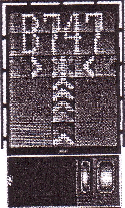 | CAPTURE The floating arrows indicate that the system is activated and in capture mode, searching for an approaching aircraft. If shall be checked that the correct aircraft type is displayed. The lead-in line shall be followed. The pilot must not proceed beyond the bridge, unless the arrows have been superseded by closing rate bar. |
 | TRACKING When the aircraft has been caught by the laser, the floating arrow is replaced by the yellow centre line indicator. A flashing red arrow indicates the direction to turn. The vertical yellow arrow shows position in relation to the centre line. This indicator give correct position and azimuth guidance. |
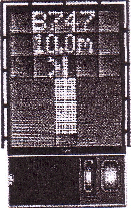 | CLOSING RATE Display of digital countdown will start when the aircraft is 20 M from stop position. When the aircraft is less than 12 M from the stop position, the closing rate is indicated by turning off one row of the centre line symbol per 0.5 M, covered by the aircraft. Thus, when the last row is turned off, 0.5 M remains to stop. |
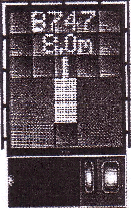 | ALIGNED TO CENTRE The aircraft is 8 M from the stop position. The absence of any direction arrow indicates an aircraft on the centre line. |
 | SLOW DOWN . If the aircraft is approaching faster than the accepted speed, the system will show SLOW DOWN as a warning to the pilot |
 | AZIMUTH GUIDANCE. The aircraft is 4 M from the stop-position. The yellow arrow indicates an aircraft to the right of the centre line, and the red flashing arrow indicates the direction to turn. |
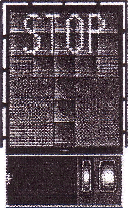 | STOP POSITION REACHED . When the correct stop-position is reached, the display will show STOP and red lights will be lit. |
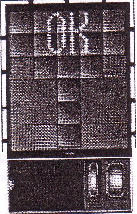 | DOCKING COMPLETE . When the aircraft has parked, OK will be displayed. |
 | OVERSHOOT . If the aircraft overshoot the stop-position, TOO FAR will be displayed. |
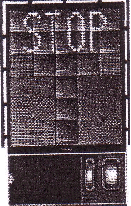  | STOP SHORT . If the aircraft is found standing still but has not reached the intended stop position, the message STOP OK will be shown after a while. |
 | WAIT . If some object is blocking the view toward the approaching aircraft or the detected aircraft is lost during docking, before 12 M to STOP, the display will show WAIT. The docking will continue as soon as the blocking object has disappeared or the system detects the aircraft again. As the aircraft is approaching the stop position, the aircraft geometry is being checked. If, for any reason, aircraft verification is not made 12 M before the stop-position, the display will show WAIT, STOP and ID FAIL. The text will be alternating on the upper two row of the display . The pilot must not proceed beyond the bridge, unless the “WAIT” message has been superseded by the closing rate bar. |
 | BAD WEATHER CONDITION . During heavy fog, rain or snow, the visibility for the docking system can be reduced. When the system is activated and in capture mode, the display will deactivate the floating arrows and show DOWN GRADE. This message will be superseded by the closing rate bar, as soon as the System detects the approaching aircraft. The pilot must not proceed beyond the bridge, unless the DOWN GRADE text has been superseded by the closing rate bar. |
  | AIRCRAFT VERIFICATION FAILURE . During entry into the stand, the aircraft geometry is being checked. If, for any reason, aircraft verification is not made 40 FT metres before the stop-position, the display will first show WAIT and make a second verification check. If this fails STOP and ID FAIL will be displayed. The text will be alternating on the upper two rows of the display. The pilot must not proceed beyond the bridge without manual guidance, unless the WAIT message has been superseded by the closing rate bar. |
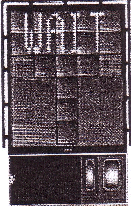 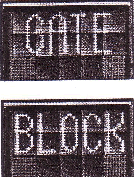 | GATE BLOCKED . If an object is found blocking the view from the DGS to the planned stop position for the aircraft, the docking procedure will be halted with a GATE BLOCK message. The docking procedure will resume as soon as the blocking object has been removed. The pilot must not proceed beyond the bridge without manual guidance, unless the WAIT message has been superseded by the closing rate bar. |
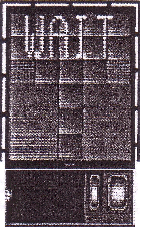  | VIEW BLOCKED If the view towards the approaching aircraft is hindered for instance by dirt on the window, the DGS will report a view block condition. Once the system is able to see the aircraft through the dirt, the message will be replaced with a closing rate display. The pilot must not proceed beyond the bridge without manual guidance, unless the WAIT message has been superseded by the closing rate bar |
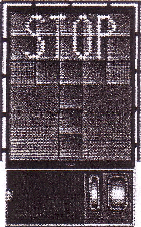  | SBU-STOP Any unrecoverable error during the docking procedure will generate an SBU condition. The display will show red stop bar and the text STOP SBU. A manual backup procedure must be used for docking guidance. |
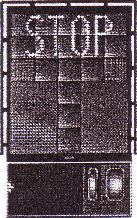 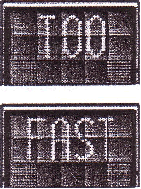 | TOO FAST If the aircraft approaches with a speed higher than the docking system can handle, the message STOP (with red squares) and TOO FAST will be displayed. The docking system must be re-started or docking procedure completed by manual guidance. |
 | EMERGENCY STOP When the emergency stop button is pressed, STOP is displayed. |
 | CHOCKS ON CHOCK ON will be displayed, when the ground staff has put the chocks in front of the nose wheel and pressed the “Chocks On” button on the operator panel. |
 | ERROR If a system error occurs, the message ERROR is display with an error code. The code is used for maintenance purposes and explained else where. |
 | SYSTEM BREAKDOWN In case of a severe system failure, the display will go black, except for a red stop indicator. A manual backup procedure must be used for docking guidance. POWER FAILURE In case of a power failure, the display will be completely black. A manual backup procedure must be used for docking guidance. |
5. OPERATION PROCEDURES OF AIRCRAFT STAND NR 20R FOR GROUND HANDLING AGENTS
6. PUSH BACK PROCEDURE
push back clearance.
push-back tug and shall taxi with minimum breakaway thrust.
his aircraft starting up.
the Standard Taxi Routes by using push-back tug.
7. SELF- MANEUVERING
VTCC AD 2.21 NOISE ABATEMENT PROCEDURES
NIL
VTCC AD 2.22 FLIGHT PROCEDURE
1. VFR HELICOPTER ROUTES WITHIN CHIANG MAI INTERNATIONAL AIRPORT AREA
Helicopter Operating Procedures as follow;
| No. | Reporting Point | Landmark | Radial/DME from CMA VOR | Lat/Long |
|---|---|---|---|---|
| 1. | MAE RIM | Dararassamee Police Camp | R-354/9.0D | 185456.84N 985631.35E |
| 2. | MAE JO | Mae Jo Junction | R-021/8.1D | 185334.55N 990037.99E |
| 3. | PA LAN | Bor Hin Intersection | R-039/8.3D | 185228.96N 990305.72E |
| 4. | SAN NA MENG | West of the 8 Building | R-055/6.4D | 184945.62N 990305.78E |
| 5. | SAN KLANG | San Klang Village | R-088/5.2D | 184611.43N 990305.67E |
| 6. | BO SANG | Bo Sang Intersection | R-092/6.8D | 184550.47N 990452.92E |
| 7. | TOT | TOT Office Building | R-131/6.7D | 184139.58N 990305.75E |
| 8. | DOI TI | Doi Ti Junction | R-159/13.9D | 183259.96N 990305.68E |
| 9. | TON TONG | South of School | R-185/13.6D | 183220.64N 985639.70E |
| 10. | THA WANG PRAO | Tha Wang Prao Intersection | R-203/15.1D | 183150.66N 985146.99E |
| 11. | NAM PRAE | Reservoir | R-228/6.8D | 184121.00N 985226.00E |
| 12. | ROYAL FLORA | Royal Park Rajapruek | R-242/2.3D | 184449.59N 985531.47E |
| Direction of Flight | Reporting Point | Reporting Point | Reporting Point | Reporting Point | Reporting Point |
|---|---|---|---|---|---|
| VTCC – NORTHWEST BOUND AND NORTHBOUND | SAN KLANG | SAN NA MENG | PA LAN | MAE JO | MAE RIM |
| VTCC – NORTHEAST BOUND | SAN KLANG | SAN NA MENG | |||
| VTCC – EASTBOUND | SAN KLANG | ||||
| VTCC – SOUTHEAST BOUND AND SOUTHBOUND | SAN KLANG | TOT | DOI TI | ||
| VTCC – WESTBOUND AND SOUTHWEST BOUND | ROYAL FLORA | NAM PRAE | THA WANG PRAO |
| Direction of Flight | Reporting Point | Reporting Point | Reporting Point | Reporting Point | Reporting Point | Reporting Point |
|---|---|---|---|---|---|---|
| HDR – EASTBOUND | MAE JO | PA LAN | SAN NA MENG | BO SANG | ||
| HDR – SOUTHEAST BOUND AND SOUTHBOUND | MAE JO | PA LAN | SAN NA MENG | SAN KLANG | TOT | DOI TI |
| HDR – SOUTHWEST BOUND | MAE JO | PA LAN | SAN NA MENG | SAN KLANG | TOT | DOI TI |
| TON TONG | THA WANG PRAO |
| Direction of Flight | Reporting Point | Reporting Point | Reporting Point | Reporting Point | Reporting Point | Reporting Point |
|---|---|---|---|---|---|---|
| HKN – NORTHEAST BOUND | PA LAN | |||||
| HKN – EASTBOUND | PA LAN | SAN NA MENG | BO SANG | |||
| HKN – SOUTHEAST BOUND AND SOUTHBOUND | PA LAN | SAN NA MENG | SAN KLANG | TOT | DOI TI | |
| HDR – SOUTHWEST BOUND | PA LAN | SAN NA MENG | SAN KLANG | TOT | DOI TI | TON TONG |
| THA WANG PRAO |
| Direction of Flight | Reporting Point | Reporting Point | Reporting Point | Reporting Point | Reporting Point | Reporting Point |
|---|---|---|---|---|---|---|
| HPK – NORTHWEST BOUND AND NORTHBOUND | PA LAN | MAE JO | MAE RIM | |||
| HPK – NORTHEAST BOUND | PA LAN | |||||
| HPK – EASTBOUND | PA LAN | SAN NA MENG | BO SANG | |||
| HPK – SOUTHEAST BOUND AND SOUTHBOUND | PA LAN | SAN NA MENG | SAN KLANG | TOT | DOI TI | |
| HPK – SOUTHWEST BOUND | PA LAN | SAN NA MENG | SAN KLANG | TOT | DOI TI | TON TONG |
| THA WANG PRAO |
| Direction of Flight | Reporting Point | Reporting Point | Reporting Point | Reporting Point | Reporting Point | Reporting Point |
|---|---|---|---|---|---|---|
| HNH – WESTBOUND NORTHWEST BOUND AND NORTHBOUND | SAN NA MENG | PA LAN | MAE JO | MAE RIM | ||
| HNH – NORTHEAST BOUND | SAN NA MENG | |||||
| HNH – EASTBOUND | SAN NA MENG | BO SANG | ||||
| HNH – SOUTHEAST BOUND AND SOUTHBOUND | SAN NA MENG | SAN KLANG | TOT | DOI TI | ||
| HNH – SOUTHWEST BOUND | SAN NA MENG | SAN KLANG | TOT | DOI TI | TON TONG | THA WANG PRAO |
| Direction of Flight | Reporting Point | Reporting Point | Reporting Point | Reporting Point | Reporting Point |
|---|---|---|---|---|---|
| HKW – NORTHWEST BOUND AND NORTHBOUND | SAN KLANG | SAN NA MENG | PA LAN | MAE JO | MAE RIM |
| HKW – NORTHEAST BOUND | SAN KLANG | SAN NA MENG | |||
| HKW – EASTBOUND | SAN KLANG | ||||
| HKW – SOUTHEAST BOUND AND SOUTHBOUND | SAN KLANG | TOT | DOI TI | ||
| HKW – SOUTHWEST BOUND | SAN KLANG | TOT | DOI TI | TON TONG | THA WANG PRAO |
| Direction of Flight | Reporting Point | Reporting Point | Reporting Point | Reporting Point | Reporting Point |
|---|---|---|---|---|---|
| HRS –NORTHBOUND | SAN KLANG | SAN NA MENG | PA LAN | MAE JO | MAE RIM |
| HRS – NORTHEAST BOUND | SAN KLANG | SAN NA MENG | |||
| HRS – EASTBOUND | SAN KLANG | ||||
| HRS – SOUTHBOUND SOUTHEAST BOUND AND SOUTHWEST BOUND | NAM PRAE | THA WANG PRAO |
| Direction of Flight | Reporting Point | Reporting Point | Reporting Point | Reporting Point | Reporting Point | Reporting Point |
|---|---|---|---|---|---|---|
| HEG – NORTHBOUND | TOT | SAN KLANG | SAN NA MENG | PA LAN | MAE JO | MAE RIM |
| HEG – NORTHEAST BOUND | TOT | SAN KLANG | SAN NA MENG | |||
| HEG – EASTBOUND | TOT | SAN KLANG | ||||
| HEG – SOUTHBOUND SOUTHEAST BOUND AND SOUTHWEST BOUND | NAM PRAE | THA WANG PRAO |

2. SPEED CONTROL PROCEDURE IN CHIANG MAI TMA
-
All arriving turbo-propeller and turbo-jet aircraft when flying below 10000 FT AMSL are subject to fly not faster than indicated air speed 250 knots unless authorized by ATC.
-
Speed will be reduced to 220 knots during 20-25 track miles from touchdown.
-
180 knots at Intermediate fix (Including aircraft from RNAV STAR), or shortly before closing heading to intercept or to establish the final course,
-
150 to 160 knots at FAP or FAF; all speed to be flown as accurately as possible. At the other times, speed control may be applied on a tactical basis to extent determined by ATC.
-
Pilots who unable to comply with the speed limits specifics above for reasons of flight safety and/or weather conditions should inform ATC and state the speed acceptable.
-
ATC will notify that the aircraft may keep its preferred speed without restriction and will use the phrase “NO SPEED RESTRICTIONS”. An instruction to notify that the aircraft need no longer comply with the previous issued speed restriction, the phrase “RESUME NORMAL SPEED” will be used.
-
All aircraft navigating under conditions of RNAV STARs shall conform to speed limitation as published then at IF pilot shall comply with speed control procedures unless otherwise instructed by ATC.
-
If the pilots do not comply, the flight shall follow ATC instruction for re-sequencing.
NOTE - an instruction to “RESUME NORMAL SPEED” does not cancel speed restrictions that applicable to published procedure of upcoming segments of flight, aircraft shall comply speed restrictions specified in a) b) c) and d)
VTCC AD 2.23 ADDITIONAL INFORMATION
1. OPERATION OF ALL NON-SCHEDULED FLIGHT AT CHIANG MAI INTERNATIONAL AIRPORT
Remark : Aircraft below letter “C” is allowed to self-manoeuvre but must inform to Chiang Mai International Airport before doing so. Moreover, aircraft below letter “C” shall be correctly bonded and correct earthing procedure shall be employed.
2. BIRD CONCENTRATIONS
Chiang Mai International Airport has implemented various kinds of wildlife management programme to prevent the attraction of birds on its boundary along with dispersal tasks to tackle the number of birds that may potentially endanger the operating aircraft. Nevertheless, due to the factors that are beyond the airport capability or authority, certain types of birds are present below.
| Common name | Weight (KG) | Period |
|---|---|---|
| Black-eared Kite | 0.56 - 0.94 | October – February (Winter Migration) |
| Common Rock Dove | 0.18 – 0.36 | All year (Particularly in April - September) |
| Red-Wattled Lapwing | 0.11-0.23 | All year |
grass areas outside the boundary of runways strip and the critical area
grass areas outside the boundary of taxiways strip. For safety reasons, the work will stop when taxiing aircraft approaches.
VTCC AD 2.24 CHARTS RELATED TO AN AERODROME
|
Chart name |
Page |
|---|---|
|
Aerodrome chart - ICAO | AD 2-VTCC-2-1 |
|
Aircraft Parking/Docking Chart – ICAO | AD 2-VTCC-2-3 |
|
Aerodrome Ground Movement Chart - ICAO | AD 2-VTCC-2-5 |
|
Aerodrome Obstacle Chart - ICAO Type A - RWY 18/36 | AD 2-VTCC-3-1 |
|
Standard Departure Chart - Instrument (SID) - ICAO - RWY 18 | AD 2-VTCC-6-1 |
|
Standard Departure Chart - Instrument (SID) - ICAO - RWY 18 (Tabular description 1) | AD 2-VTCC-6-2 |
|
Standard Departure Chart - Instrument (SID) - ICAO - RWY 18 (Tabular description 2) | AD 2-VTCC-6-3 |
|
Standard Departure Chart - Instrument (SID) - ICAO - RWY 36 | AD 2-VTCC-6-5 |
|
Standard Departure Chart - Instrument (SID) - ICAO - RWY 36 (Tabular description 1) | AD 2-VTCC-6-6 |
|
Standard Departure Chart - Instrument (SID) - ICAO - RWY 36 (Tabular description 2) | AD 2-VTCC-6-7 |
|
Standard Departure Chart - Instrument (SID) - ICAO - RNAV RWY 18 - ENBAT2S GOGOP2S PANTA2S PUMAM2S | AD 2-VTCC-6-9 |
|
Standard Departure Chart - Instrument (SID) - ICAO - RNAV RWY 18 - ENBAT2S GOGOP2S PANTA2S PUMAM2S (Tabular description) | AD 2-VTCC-6-10 |
|
Standard Departure Chart - Instrument (SID) - ICAO - RNAV RWY 18 - ASAVI2S KABMU2S MONLO2S | AD 2-VTCC-6-11 |
|
Standard Departure Chart - Instrument (SID) - ICAO - RNAV RWY 18 - ASAVI2S KABMU2S MONLO2S (Tabular description) | AD 2-VTCC-6-12 |
|
Standard Departure Chart - Instrument (SID) - ICAO - RNAV RWY 18 - ADLUS2S LAMUN2S VISES2S | AD 2-VTCC-6-13 |
|
Standard Departure Chart - Instrument (SID) - ICAO - RNAV RWY 18 - ADLUS2S LAMUN2S VISES2S (Tabular description) | AD 2-VTCC-6-14 |
|
Standard Departure Chart - Instrument (SID) - ICAO - RNAV RWY 18 - ADLUS2S LAMUN2S VISES2S (Waypoint list table) | AD 2-VTCC-6-15 |
|
Standard Departure Chart - Instrument (SID) - ICAO - RNAV RWY 18 - LAMUN2W VISES2W | AD 2-VTCC-6-17 |
|
Standard Departure Chart - Instrument (SID) - ICAO - RNAV RWY 18 - LAMUN2W VISES2W (Tabular description) | AD 2-VTCC-6-18 |
|
Standard Departure Chart - Instrument (SID) - ICAO - RNAV RWY 36 - ASAVI2N ENBAT2N GOGOP2N KABMU2N MONLO2N PANTA2N PUMAM2N | AD 2-VTCC-6-19 |
|
Standard Departure Chart - Instrument (SID) - ICAO - RNAV RWY 36 - ASAVI2N ENBAT2N GOGOP2N KABMU2N MONLO2N PANTA2N PUMAM2N (Tabular description 1) | AD 2-VTCC-6-20 |
|
Standard Departure Chart - Instrument (SID) - ICAO - RNAV RWY 36 - ASAVI2N ENBAT2N GOGOP2N KABMU2N MONLO2N PANTA2N PUMAM2N (Tabular description 2) | AD 2-VTCC-6-21 |
|
Standard Departure Chart - Instrument (SID) - ICAO - RNAV RWY 36 - ASAVI2N ENBAT2N GOGOP2N KABMU2N MONLO2N PANTA2N PUMAM2N (Waypoint list table) | AD 2-VTCC-6-22 |
|
Standard Departure Chart - Instrument (SID) - ICAO - RNAV RWY 36 - ASAVI2C ENBAT2C GOGOP2C KABMU2C MONLO2C PANTA2C PUMAM2C | AD 2-VTCC-6-23 |
|
Standard Departure Chart - Instrument (SID) - ICAO - RNAV RWY 36 - ASAVI2C ENBAT2C GOGOP2C KABMU2C MONLO2C PANTA2C PUMAM2C (Tabular description 1) | AD 2-VTCC-6-24 |
|
Standard Departure Chart - Instrument (SID) - ICAO - RNAV RWY 36 - ASAVI2C ENBAT2C GOGOP2C KABMU2C MONLO2C PANTA2C PUMAM2C (Tabular description 2) | AD 2-VTCC-6-25 |
|
Standard Departure Chart - Instrument (SID) - ICAO - RNAV RWY 36 - ASAVI2C ENBAT2C GOGOP2C KABMU2C MONLO2C PANTA2C PUMAM2C (Waypoint list table) | AD 2-VTCC-6-26 |
|
Standard Departure Chart - Instrument (SID) - ICAO - RNAV RWY 36 - LAMUN2N VISES2N | AD 2-VTCC-6-27 |
|
Standard Departure Chart - Instrument (SID) - ICAO - RNAV RWY 36 - LAMUN2N VISES2N (Tabular description) | AD 2-VTCC-6-28 |
|
Standard Departure Chart - Instrument (SID) - ICAO - RNAV RWY 36 - ADLUS2N | AD 2-VTCC-6-29 |
|
Standard Departure Chart - Instrument (SID) - ICAO - RNAV RWY 36 - ADLUS2N (Tabular description) | AD 2-VTCC-6-30 |
|
Standard Arrival Chart - Instrument (STAR) - ICAO - RNAV RWY 18 - ADLUS2B ASAVI2B CMA2B ENBAT2B GOGOP2B KABMU2B MARNI2B MONLO2B PANTA2B PUMAM2B | AD 2-VTCC-7-1 |
|
Standard Arrival Chart - Instrument (STAR) - ICAO - RNAV RWY 18 - ADLUS2B ASAVI2B CMA2B ENBAT2B GOGOP2B KABMU2B MARNI2B MONLO2B PANTA2B PUMAM2B (Radio communication failure table) | AD 2-VTCC-7-2 |
|
Standard Arrival Chart - Instrument (STAR) - ICAO - RNAV RWY 18 - ADLUS2B ASAVI2B CMA2B ENBAT2B GOGOP2B KABMU2B MARNI2B MONLO2B PANTA2B PUMAM2B (Tabular description 1) | AD 2-VTCC-7-3 |
|
Standard Arrival Chart - Instrument (STAR) - ICAO - RNAV RWY 18 - ADLUS2B ASAVI2B CMA2B ENBAT2B GOGOP2B KABMU2B MARNI2B MONLO2B PANTA2B PUMAM2B (Tabular description 2) | AD 2-VTCC-7-4 |
|
Standard Arrival Chart - Instrument (STAR) - ICAO - RNAV RWY 18 - ADLUS2B ASAVI2B CMA2B ENBAT2B GOGOP2B KABMU2B MARNI2B MONLO2B PANTA2B PUMAM2B (Tabular description 3) | AD 2-VTCC-7-5 |
|
Standard Arrival Chart - Instrument (STAR) - ICAO - RNAV RWY 18 - ADLUS2B ASAVI2B CMA2B ENBAT2B GOGOP2B KABMU2B MARNI2B MONLO2B PANTA2B PUMAM2B (Waypoint list table) | AD 2-VTCC-7-6 |
|
Standard Arrival Chart - Instrument (STAR) - ICAO - RNAV RWY 18 - ADLUS2X LAMUN2X VISES2X | AD 2-VTCC-7-7 |
|
Standard Arrival Chart - Instrument (STAR) - ICAO - RNAV RWY 18 - ADLUS2X LAMUN2X VISES2X (Radio communication failure table) | AD 2-VTCC-7-8 |
|
Standard Arrival Chart - Instrument (STAR) - ICAO - RNAV RWY 18 - ADLUS2X LAMUN2X VISES2X (Tabular description) | AD 2-VTCC-7-9 |
|
Standard Arrival Chart - Instrument (STAR) - ICAO - RNAV RWY 36 - ENBAT2A GOGOP2A MARNI2A PANTA2A PUMAM2A | AD 2-VTCC-7-11 |
|
Standard Arrival Chart - Instrument (STAR) - ICAO - RNAV RWY 36 - ENBAT2A GOGOP2A MARNI2A PANTA2A PUMAM2A (Radio communication failure table) | AD 2-VTCC-7-12 |
|
Standard Arrival Chart - Instrument (STAR) - ICAO - RNAV RWY 36 - ENBAT2A GOGOP2A MARNI2A PANTA2A PUMAM2A (Tabular description) | AD 2-VTCC-7-13 |
|
Standard Arrival Chart - Instrument (STAR) - ICAO - RNAV RWY 36 - ENBAT2A GOGOP2A MARNI2A PANTA2A PUMAM2A (Waypoint list table) | AD 2-VTCC-7-14 |
|
Standard Arrival Chart - Instrument (STAR) - ICAO - RNAV RWY 36 - ADLUS2A ASAVI2A CMA2A KABMU2A MONLO2A | AD 2-VTCC-7-15 |
|
Standard Arrival Chart - Instrument (STAR) - ICAO - RNAV RWY 36 - ADLUS2A ASAVI2A CMA2A KABMU2A MONLO2A (Radio communication failure table) | AD 2-VTCC-7-16 |
|
Standard Arrival Chart - Instrument (STAR) - ICAO - RNAV RWY 36 - ADLUS2A ASAVI2A CMA2A KABMU2A MONLO2A (Tabular description 1) | AD 2-VTCC-7-17 |
|
Standard Arrival Chart - Instrument (STAR) - ICAO - RNAV RWY 36 - ADLUS2A ASAVI2A CMA2A KABMU2A MONLO2A (Tabular description 2) | AD 2-VTCC-7-18 |
|
Standard Arrival Chart - Instrument (STAR) - ICAO - RNAV RWY 36 - LAMUN2A VISES2A | AD 2-VTCC-7-19 |
|
Standard Arrival Chart - Instrument (STAR) - ICAO - RNAV RWY 36 - LAMUN2A VISES2A (Radio communication failure table) | AD 2-VTCC-7-20 |
|
Standard Arrival Chart - Instrument (STAR) - ICAO - RNAV RWY 36 - LAMUN2A VISES2A (Tabular description) | AD 2-VTCC-7-21 |
|
Instrument Approach Chart - ICAO - VOR a RWY 18 | AD 2-VTCC-8-1 |
|
Instrument Approach Chart - ICAO - VOR a RWY 18 (Fix and point list table) | AD 2-VTCC-8-2 |
|
Instrument Approach Chart - ICAO - VOR RWY 36 | AD 2-VTCC-8-3 |
|
Instrument Approach Chart - ICAO - VOR RWY 36 (Fix and point list table) | AD 2-VTCC-8-4 |
|
Instrument Approach Chart - ICAO - ILS or LOC y RWY 36 | AD 2-VTCC-8-5 |
|
Instrument Approach Chart - ICAO - ILS or LOC y RWY 36 (Fix and point list table) | AD 2-VTCC-8-6 |
|
Instrument Approach Chart - ICAO - ILS or LOC z RWY 36 | AD 2-VTCC-8-7 |
|
Instrument Approach Chart - ICAO - ILS or LOC z RWY 36 (Tabular description) | AD 2-VTCC-8-8 |
|
Instrument Approach Chart - ICAO - ILS or LOC z RWY 36 (Fix and point list table) | AD 2-VTCC-8-9 |
|
Instrument Approach Chart - ICAO - RNP RWY 18 | AD 2-VTCC-8-11 |
|
Instrument Approach Chart - ICAO - RNP RWY 18 (Tabular description) | AD 2-VTCC-8-12 |
|
Instrument Approach Chart - ICAO - RNP RWY 36 | AD 2-VTCC-8-13 |
|
Instrument Approach Chart - ICAO - RNP RWY 36 (Tabular description) | AD 2-VTCC-8-14 |